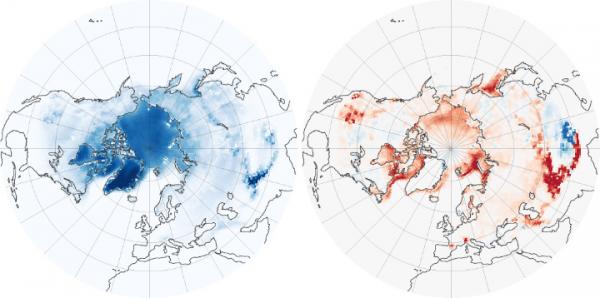Less Snow, Ice Leads to Warmer Globe


Less snow and ice on the top of the globe is leading to a warmer world, according to a recent study released by NASA today.
The loss of snow and ice in the Northern Hemisphere has warmed the planet in the last 30 years more than models predicted it would, the researchers found in a study detailed in the Jan. 16 edition of the journal Nature Geoscience.
Snow and ice cool the planet. They help regulate how much of the sun's energy the Earth absorbs. Bright white snow and ice reflect some heat energy back to space, keeping the Earth cool, according to a NASA statement. With less snow and ice cover, the Earth will absorb more of the sun's energy, heating the planet, and leading to more snow and ice melting.
NASA's study also was illustrated by an accompanying graphic. The NASA images above show what happens when that cooling ice starts to disappear. The left image shows how much energy the Northern Hemisphere's snow and ice called the cryosphere reflected on average between 1979 and 2008. Dark blue indicates more reflected energy, in Watts per square meter, and thus more cooling.
The Greenland ice sheet reflects more energy than any other single location in the Northern Hemisphere. The second-largest contributor to cooling is the cap of sea ice over the Arctic Ocean.
The above right image shows how the energy being reflected from the cryosphere has changed between 1979 and 2008. When snow and ice disappear, they are replaced by dark land or ocean, both of which absorb energy. The image shows that the Northern Hemisphere is absorbing more energy, particularly along the outer edges of the Arctic Ocean, where sea ice has disappeared, and in the mountains of Central Asia, than it did a few decades ago.
"On average, the Northern Hemisphere now absorbs about 100 PetaWatts more solar energy because of changes in snow and ice cover," said study team member Mark Flanner of the University of Michigan. "To put it in perspective, 100 PetaWatts is sevenfold greater than all the energy humans use in a year." (1 PetaWatt is equal to 1 quadrillion Watts that's a one followed by 15 zeroes.)
Get the world’s most fascinating discoveries delivered straight to your inbox.
Changes in the extent and timing of snow cover account for about half of the change, while melting sea ice accounts for the other half.
The analysis is the first calculation of how much energy the entire cryosphere reflects. It is also the first observation of changes in reflected energy because of changes in the entire cryosphere.



